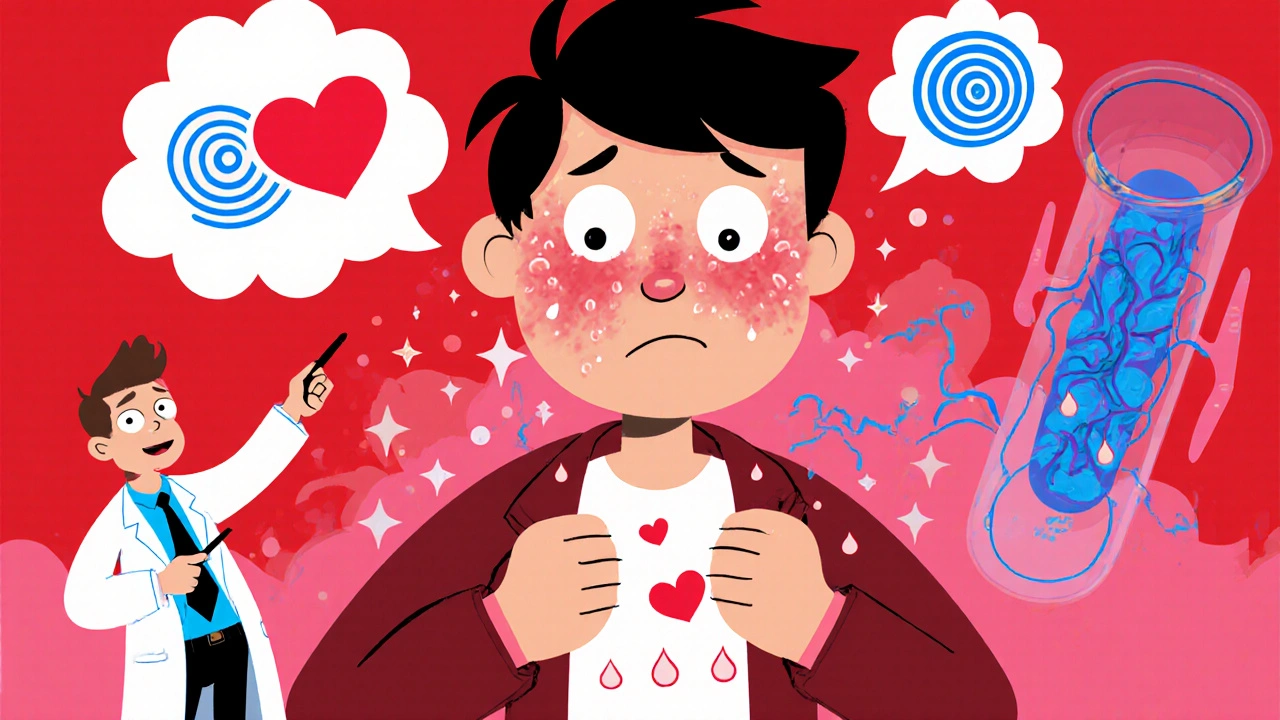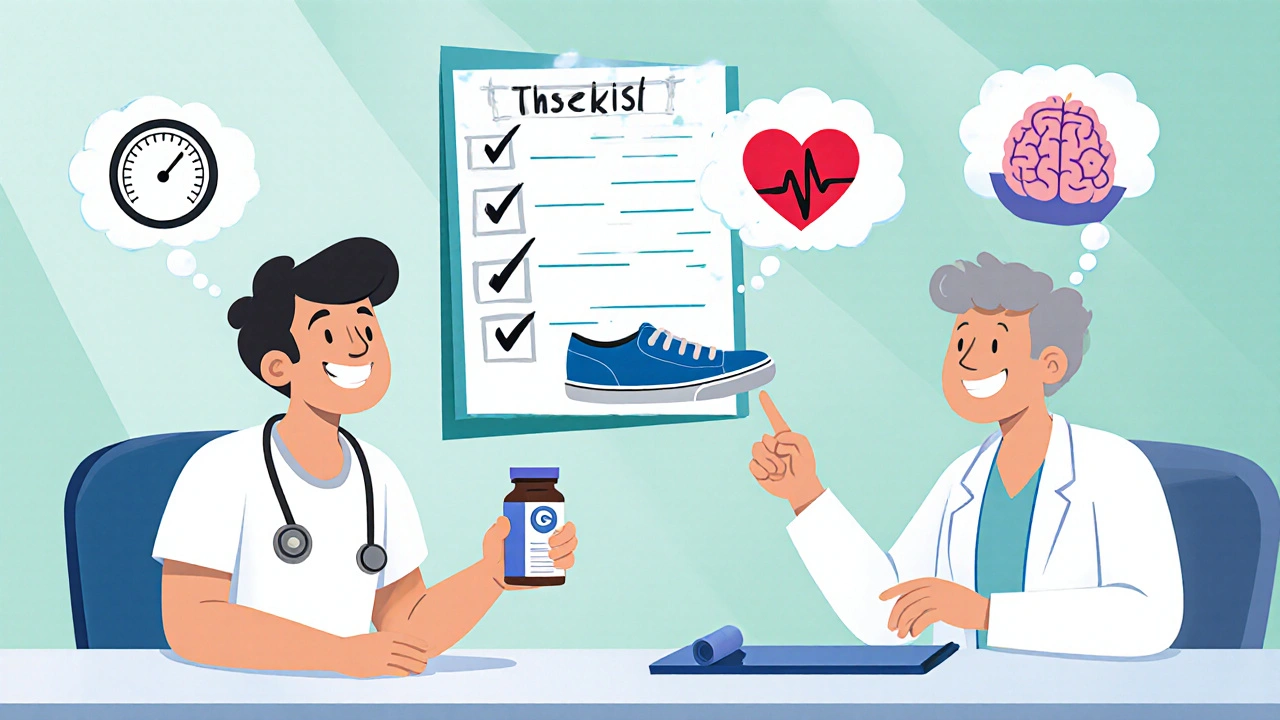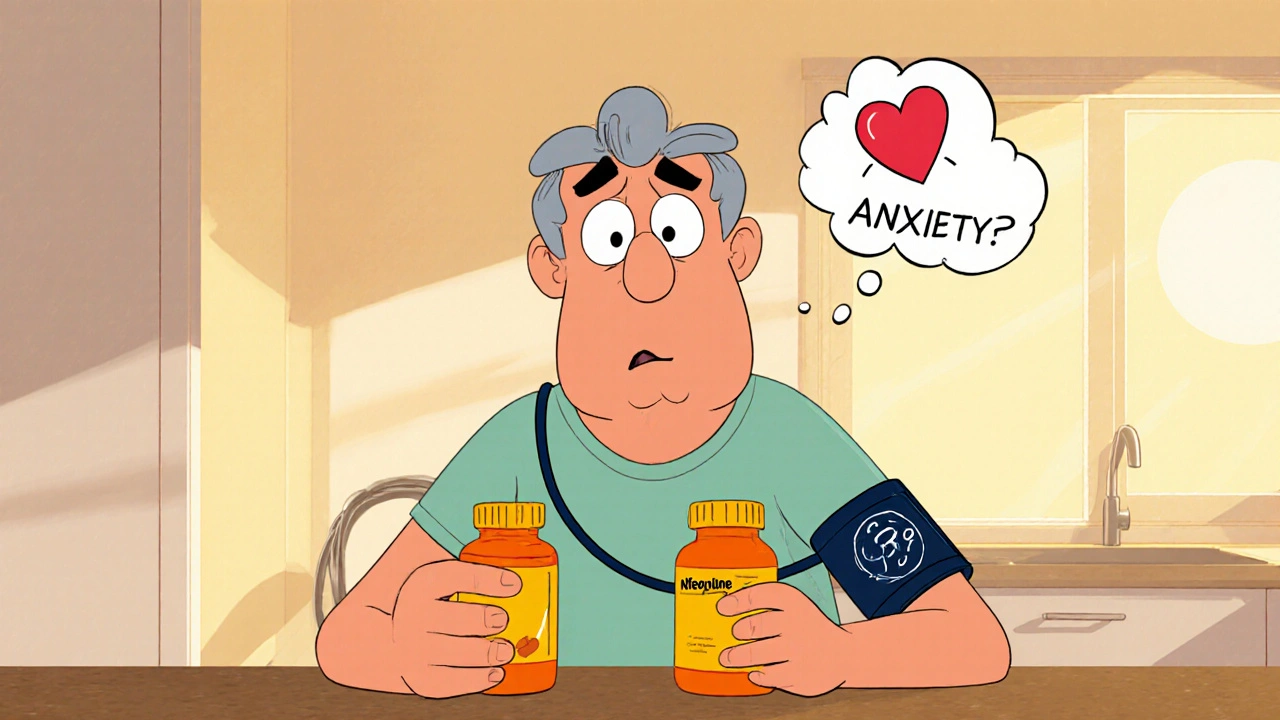Nifedipine Anxiety Tracker
Track Your Symptoms
This tool helps you determine if your anxiety symptoms might be related to nifedipine by tracking the timing of your medication doses and anxiety episodes.
People with high blood pressure sometimes wonder whether their medication could be messing with their mood. Nifedipine anxiety is a question that pops up in online forums, doctor’s offices, and even casual conversations. Below we break down what nifedipine actually does, how it might intersect with anxiety, and what you should watch out for before deciding if it’s a help or a hindrance.
What is Nifedipine?
Nifedipine is a dihydropyridine calcium channel blocker (CCB) prescribed mainly for hypertension and angina. It works by relaxing the smooth muscle in arterial walls, which lowers peripheral resistance and eases the heart’s workload. First approved in the early 1980s, nifedipine has become a staple in the Australian Therapeutic Goods Administration (TGA) formulary for chronic blood‑pressure control.
How Calcium Channel Blockers Operate
Calcium channel blockers, including nifedipine, target L‑type calcium channels on vascular smooth muscle. By preventing calcium influx, they inhibit the contraction cascade that would otherwise narrow blood vessels. The net effect is vasodilation, reduced systolic pressure, and lower cardiac oxygen demand. Because the drug acts primarily on peripheral vessels rather than the central nervous system, it’s often considered “cardio‑specific” compared with beta‑blockers that also have central effects.
Understanding Anxiety: A Quick Primer
Anxiety is a state of excessive worry, nervousness, or fear that can manifest physically (e.g., rapid heartbeat, sweating) and mentally (e.g., racing thoughts). While occasional anxiety is a normal response to stress, chronic anxiety disorders involve persistent, disproportionate fear that interferes with daily life. Neurotransmitters such as GABA, serotonin, and norepinephrine play major roles, and dysregulation of the hypothalamic‑pituitary‑adrenal (HPA) axis often contributes to heightened cortisol levels.
Why Might Nifedipine Influence Anxiety?
The link between a blood‑pressure drug and a mental‑health symptom isn’t obvious, but there are three plausible pathways:
- Hemodynamic fluctuations: Sudden drops in blood pressure (orthostatic hypotension) can trigger dizziness, palpitations, and a sense of panic, especially in people already prone to anxiety.
- Peripheral side effects that mimic anxiety: Nifedipine can cause flushing, headache, and tachycardia-symptoms that many mistake for a panic attack.
- Drug‑drug interactions: When combined with medications that affect the central nervous system (e.g., SSRIs, benzodiazepines), nifedipine may alter plasma concentrations, potentially intensifying or dampening anxiety‑related effects.
None of these mechanisms suggest a direct anxiolytic property; rather, they highlight how the drug’s cardiovascular actions can indirectly shape emotional perception.

What Does the Research Say?
Clinical data on nifedipine’s impact on anxiety is sparse, largely because trials focus on cardiovascular endpoints. However, a handful of observational studies and case reports provide useful clues:
- Case series from 2022 (Australia): Ten patients with hypertension reported new‑onset anxiety after starting extended‑release nifedipine. Symptoms subsided when the dose was reduced or switched to an alternative CCB.
- Cross‑sectional survey (2023, Europe): Among 1,200 adults on antihypertensives, those on dihydropyridine CCBs had a modestly higher self‑reported anxiety score (mean difference=0.4 on a 7‑point scale) compared with those on ACE inhibitors.
- Pharmacodynamic modelling (2024, US): Simulations suggest that high plasma levels of nifedipine can stimulate sympathetic activity via baroreceptor reflexes, a physiological route that could aggravate anxiety in susceptible individuals.
Importantly, none of these sources establish causation, and many confounding factors (e.g., underlying cardiovascular stress) remain. The consensus among cardiology and psychiatry societies is that nifedipine is “neutral” for anxiety-neither a treatment nor a proven trigger-but clinicians should stay alert to individual reactions.
Side Effects That May Be Mistaken for Anxiety
Understanding which adverse events overlap with anxiety helps you differentiate medication‑related issues from a primary anxiety disorder:
| Side Effect | Typical Onset | Why It Feels Like Anxiety |
|---|---|---|
| Headache | Within 1‑2 weeks | Pulsating pain can trigger worry about health |
| Flushing | Immediately after dose | Warmth and rapid heartbeat are classic panic cues |
| Tachycardia | During dose peaks | Fast heart rate is a hallmark of panic attacks |
| Dizziness | First month | Light‑headedness can be interpreted as a loss of control |
Interactions with Common Anxiety Medications
When you’re already on an anti‑anxiety regimen, adding nifedipine can create a pharmacokinetic ripple effect. Below are the most relevant pairings:
- Beta blockers (e.g., propranolol): Both lower heart rate, so combined use may cause excessive bradycardia. Yet beta blockers are sometimes prescribed off‑label for performance anxiety, so physicians may adjust doses.
- Selective serotonin reuptake inhibitors (SSRIs) such as sertraline: SSRIs inhibit CYP2C19, a pathway that metabolizes certain nifedipine formulations. This can raise nifedipine plasma levels, heightening side‑effect risk.
- Benzodiazepines (e.g., lorazepam): No major metabolic clash, but the sedative effect of benzodiazepines can mask nifedipine‑induced dizziness, making it harder to spot the cause.
Always discuss your full medication list with a pharmacist or prescriber before making changes.

Clinical Decision‑Making: When to Keep or Switch Nifedipine
Here’s a quick checklist for doctors and patients to decide whether nifedipine is still the right choice:
- Blood‑pressure control: If nifedipine is bringing numbers into target range without frequent dose adjustments, that’s a strong point in its favor.
- New or worsening anxiety symptoms: Document onset, severity, and temporal relation to dose changes.
- Side‑effect burden: Frequent headaches, flushing, or tachycardia that interfere with daily life suggest a switch.
- Drug‑interaction profile: If you’re on multiple CYP‑interacting agents, consider an alternative antihypertensive with a cleaner metabolic pathway (e.g., ACE inhibitor).
- Patient preference: Some people value once‑daily dosing; others prioritize a medication with minimal central nervous system impact.
When the balance tips toward anxiety‑related drawbacks, clinicians often transition patients to other classes such as ACE inhibitors, ARBs, or even a different CCB like amlodipine, which has a slightly lower incidence of tachycardia.
Alternative Strategies for Managing Anxiety While on Nifedipine
If you need to stay on nifedipine for cardiovascular reasons, you can still tackle anxiety through non‑pharmacological and pharmacological means:
- Cognitive‑behavioral therapy (CBT): Proven to reduce worry and panic frequency without any drug interactions.
- Mind‑body techniques: Breathwork, progressive muscle relaxation, and guided imagery can calm the sympathetic surge that sometimes follows blood‑pressure dips.
- Lifestyle tweaks: Regular aerobic exercise improves endothelial function and reduces both BP and anxiety scores.
- Medication adjuncts: Low‑dose SSRIs or buspirone can be added safely, provided dose timing avoids peak nifedipine concentrations.
Always coordinate with both your cardiologist and mental‑health provider to keep communication lines open.
Key Takeaways
- Nifedipine is a calcium channel blocker that primarily lowers blood pressure by relaxing arterial smooth muscle.
- It does not have inherent anxiolytic properties, but side effects like flushing, headache, and tachycardia can be misread as anxiety.
- Evidence is limited; most data show a neutral to slightly aggravating effect on anxiety, especially at high doses.
- Drug interactions with SSRIs, beta blockers, and benzodiazepines should be reviewed carefully.
- If anxiety worsens, consider dosage adjustment, switching to another antihypertensive, or adding non‑drug anxiety‑management strategies.
Frequently Asked Questions
Can nifedipine cause panic attacks?
Nifedipine itself does not trigger panic attacks, but its cardiovascular side effects-especially rapid heart rate and flushing-can mimic the physical sensations of a panic episode, leading some people to think they are experiencing a panic attack.
Is it safe to take an SSRI with nifedipine?
Generally yes, but certain SSRIs (like fluoxetine) inhibit CYP2C19, which can raise nifedipine levels. Your doctor may start with a lower nifedipine dose or monitor blood pressure more closely.
Should I switch to a different blood‑pressure medicine if I have anxiety?
If anxiety symptoms appear soon after starting nifedipine and persist despite dose adjustments, discuss alternatives with your doctor. ACE inhibitors, ARBs, or a different CCB such as amlodipine are common substitutes with fewer anxiety‑like side effects.
Can lifestyle changes reduce both my blood pressure and anxiety?
Absolutely. Regular aerobic activity, a Mediterranean‑style diet, reduced caffeine, and consistent sleep patterns improve vascular health while also lowering stress hormones that fuel anxiety.
Is there a quick test to know if my anxiety is drug‑related?
A simple approach is to track symptom timing against medication dosing. If anxiety spikes within 30‑60 minutes of taking nifedipine and eases as the drug wears off, discuss the pattern with your clinician; they may adjust timing or switch drugs.


Malia Rivera
October 16, 2025 AT 20:06When you stare at the glass of blood pressure pills and wonder if they’re secretly fueling your nerves, you’re touching on a deeper question of how we trust the chemicals that keep our hearts ticking. Nifedipine, born in the early eighties, was marketed as a hero for hypertension, a smooth‑acting calcium channel blocker that eases arterial tension without invading the brain. Yet the very mechanisms that lower pressure – vasodilation and reflex tachycardia – can send a jolt through the autonomic nervous system, the same system that lights up during panic. In people whose baseline anxiety is already high, that sudden rush of blood to the periphery can feel like the body is about to lose control, a sensation easily mistaken for a panic attack. The side‑effects list – flushing, headache, a pounding heart – reads like a checklist for anxiety triggers, and clinicians know that perception often becomes reality. What the research really tells us is that the signal isn’t direct; it’s an indirect dance between hemodynamics and the brain’s alarm system. A 2022 Australian case series noted ten patients who felt a surge of nervousness after stepping up their extended‑release dose, and most felt relief when the dose was trimmed or swapped. Across Europe in 2023, a modest bump in self‑reported anxiety scores among dihydropyridine users hinted at a pattern, though the numbers were small enough to be brushed off as noise. The 2024 pharmacodynamic model added a theoretical layer, suggesting that high plasma concentrations could tip the baroreceptor reflex toward sympathetic overdrive. Still, no large‑scale trial has ever set anxiety as a primary endpoint, so we’re left piecing together anecdote, modest data, and physiological plausibility. The key takeaway for anyone in the States is to stay vigilant: monitor how you feel after each dose, especially during the first few weeks, and keep an open line with both your cardiologist and mental‑health provider. If the anxiety feels tethered to your medication, a simple switch to amlodipine or an ACE inhibitor might spare you the extra stress. Remember, the body is a complex system, and sometimes the cure can feel like a new kind of discomfort, but with careful observation and a willingness to adjust, you can keep both your heart and mind in better shape.
Kate Marr
October 17, 2025 AT 10:33Gotta say, the US pharma scene loves pushing meds like nifedipine without always flagging the jittery side effects 😬. If you’re already battling anxiety, those flushing episodes can feel like a flare‑up of the very thing you’re trying to calm.
Mary Davies
October 18, 2025 AT 01:50The way nifedipine’s vascular smooth‑muscle relaxation can whisper to the nervous system is almost poetic, yet it can also stir the storm inside a mind already on edge. Your deep dive into the mechanistic pathways resonated with me, especially the baroreceptor reflex angle that many overlook. It’s a reminder that even “cardio‑specific” drugs have a shadow side that can ripple into mental health.
Valerie Vanderghote
October 18, 2025 AT 17:06Honestly, I’ve seen people blame every little twitch on their meds, but when you think about it, the body’s response to a sudden drop in peripheral resistance can feel like a cinematic chase scene where the heart drums faster, the skin flares hot, and the mind, already primed with worries, runs to the nearest exit, interpreting every physiological cue as a threat, which then loops back into the anxiety cycle, making it almost impossible to tell where the drug ends and the panic begins, and that’s why tracking timing and dosage becomes a critical detective work for both patient and physician alike.
Michael Dalrymple
October 19, 2025 AT 08:23From a coaching perspective, it’s valuable to treat the medication as one piece of a broader health strategy. Encourage patients to monitor symptom patterns, adjust lifestyle factors like exercise and sleep, and maintain open communication with their healthcare team. By integrating these steps, the risk of anxiety‑related side effects can be mitigated, and overall cardiovascular health can improve.
Emily (Emma) Majerus
October 19, 2025 AT 23:40Nifedipine usually doesn’t make anxiety worse.
Virginia Dominguez Gonzales
October 20, 2025 AT 14:56Imagine standing at the edge of a cliff, feeling the wind of a lowered blood pressure rush against your skin, while your heart drums a frantic rhythm; that’s the drama nifedipine can write in the story of your day. Yet, with the right coping tools-steady breathing, mindful movement, and a supportive talk-you can rewrite the ending into a calm, controlled sunrise.
Carissa Padilha
October 21, 2025 AT 06:13What if the pharma giants are deliberately downplaying the anxiety link to keep sales high? The few studies we have are tiny, and the big trials never even ask the right questions, so we’re left with a cloud of uncertainty that benefits the manufacturers more than the patients.
Richard O'Callaghan
October 21, 2025 AT 21:30i think its worth noting thata lot of people dont realize thier headach could be from nifedipine not stress there is a differece
Alexis Howard
October 22, 2025 AT 12:46just another pill no big deal